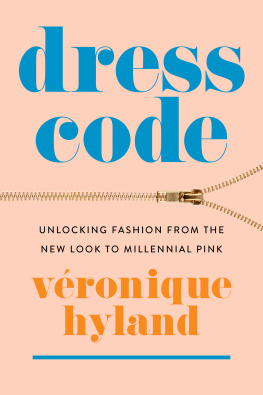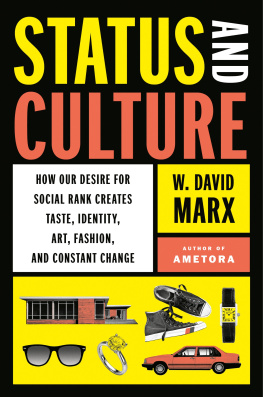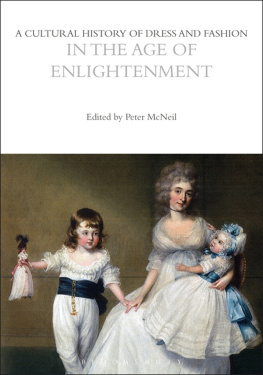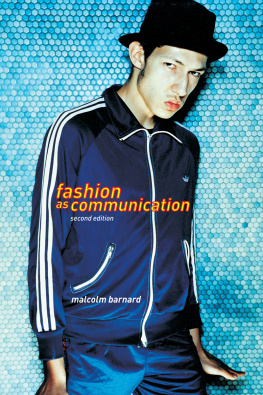FRED DAVIS
Fashion, Culture, and Identity
THE UNIVERSITY OF CHICAGO PRESS
Chicago & London
The University of Chicago Press, Chicago 60637
The University of Chicago Press, Ltd., London
1992 by The University of Chicago
All rights reserved. Published 1992.
Paperback edition 1994
Printed in the United States of America
20 19 18 17 16 15 14 13 12 11 8 9 10 11 12
ISBN-13: 978-0-226-13809-1 (paper)
ISBN-13: 978-0-226-16795-4 (ebook)
ISBN-10: 0-226-13809-7 (paper)
Library of Congress Cataloging-in-Publication Data
Davis, Fred, 19251992
Fashion, culture, and identity / Fred Davis.
p. cm.
Includes bibliographical references and index.
1. CostumeSocial aspects. 2. FashionSocial aspects. 3. Gender identity. 4. Group identity. I. Title.
GT525.D38 1992
391dc20
91-44012
CIP
 The paper used in this publication meets the minimum requirements of the American National Standard for Information SciencesPermanence of Paper for Printed Library Materials, ANSI Z39.48-1992.
The paper used in this publication meets the minimum requirements of the American National Standard for Information SciencesPermanence of Paper for Printed Library Materials, ANSI Z39.48-1992.
In memory of
HERBERT BLUMER (19001987)
from whom I took courage to treat
seriously topics thought frivolous by
American sociology
Contents
Acknowledgments
In the decade or so it took for this work to reach fruition I acquired many debts of authorship whose brief acknowledgment here can in no way recompense in adequate measure the interest, aid and support extended me by the persons, organizations and institutions I am about to mention. I apologize for this and trust that the parties can be as forgiving of the deficiency as they were generous in the time, thought, and resources they made available to me.
There is, first, my debt to the several dozen persons in the apparel trades, the fashion press and allied fields in San Diego, Los Angeles, and New York whom I interviewed. My promise of anonymity to them is not in the least intended to slight the experience and wisdom they shared with me and on which I have drawn extensively throughout this work.
The Research Committee of the Academic Senate, University of California, San Diego provided me with several small grants that greatly facilitated my research. I thank the faculty members who served on that committee at the times the grants were made. It also gives me particular pleasure, and occasions the happiest memories, to be able to thank the Rockefeller Foundation for having awarded me in 1989 a months Resident Fellowship at its Bellagio Study and Conference Center in Italy where I wrote a chapter of this book and gathered notes for another. More idyllic circumstances in which to think and write, while being kept aloft intellectually in the invigorating company of a cross-section of scholars and artists from all fields, could not, I am certain, be devised by any Utopian planner.
I owe a very special debt of gratitude to several persons without whose friendship and assistance major portions of the research entailed in this study would not have been initiated or completed. These are Robert Bass of the apparel firm JEnvie, New York, Susan Kaiser of the Division of Textiles and Clothing, University of California, Davis, Joan Kron, former editor of Avenue magazine, New York, and Raymonde Moulin, director of the Centre de Sociologie des Arts, Paris. I trust they may find in this work reason not to rue the generous offerings they made to it.
Dorothy Gaffney, a former undergraduate at the University of California, San Diego, and Sheila Hittleman-Sohn, presently a doctoral candidate in the Department of Sociology there, worked diligently with me on different facets of the research. I thank them both. My wife Marcella, whose workaday knowledge of things vestmental is exceptional, helped me over many an informational or conceptual hurdle which otherwise would have proved a barrier. I need only add my appreciation for the constancy of her encouragement to signal the important influence she has had on this work.
I wish also to make a special point of thanking the following apparel firms for their kindness in granting me gratis permission to reproduce in these pages photographs from their sales collections: Jerell Inc. (Dallas), Perry Ellis International (New York), Smith & Hawken (Mill Valley, Calif.), Talbots (Hingham, Mass.) and Tweeds Inc. (Edgewater, N.J.).
Acknowledgment is due the following for having published what are earlier versions of some chapters in this book. : Identity Ambivalence in Clothing: the Dialectic of the Erotic and the Chaste, in David Maines, ed. Social Organization and Social Process, Essays in Honor of Anselm Strauss (New York: Aldine de Gruyter, 1991).
Finally, no words other than those borne witness by the very text that follows are necessary to establish my profound, now almost an entire working lifes, indebtedness to the person to whom I dedicate this book, the late Professor Herbert Blumer. His fascination with fashion first inspired me as a young sociology graduate student at the University of Chicago in the late 1940s and it was my special good fortune to be able to continue to draw from that fount over our many years of colleagueship at the University of California.
Fred Davis
La Jolla, California
January 1992
Do Clothes Speak? What Makes them Fashion?
It is only shallow people who do not judge by appearances. The true mystery of the world is the visible, not the invisible.
Oscar Wilde
Cultural scientists must address these questions (as they have not thus far) if they are ever to make sense of a phenomenon that has periodically intrigued them, less for its own sake, unfortunately, than for the light they thought it could shed on certain fundamental features of modern society, namely, social movements, social stratification, and mass-produced tastes. I speak, of course, of fashion and some of its many facets: its sources in culture and social structure, the processes by which it diffuses within and among societies, the purposes it serves in social differentiation and social integration, the psychological needs it is said to satisfy, and, not least of all, its implications for modern economic life. But oddly, one facet sociologists have not fastened onnor for that matter have psychologists or anthropologists to any appreciable extentis that which joins the makers, purveyors, and consumers of fashion, namely, its meaning. By meaning, I refer to the images, thoughts, sentiments, and sensibilities communicated by a new or old fashion and the symbolic means by which this is done (Davis 1982). Such analytic neglect strikes me as analogous to watching a play whose dialogue is kept from us but whose gross gestural outlines, scenery, and props we are permitted to observe. Although we are likely to come away with some sense of what is going onwhether it is comedy, tragedy, or melodrama; whether it concerns love, murder, or betrayalwe would have only the vaguest idea of the whys and wherefores. In the case of the sociological interest in clothing and fashion, we know that through clothing people communicate some things about their persons, and at the collective level this results typically in locating them symbolically in some structured universe of status claims and life-style attachments. Some of us may even make so bold as to assert what these claims and attachments area tramp presuming the hauteur of a patrician, nouveau riche ostentation masking status anxietybut, as in the voiceless play, the actual symbolic content that elicits such interpretations eludes us. Lacking such knowledge, we can at best only form conclusions without quite knowing how we derived them; this is something we often have to do in everyday life, but by itself it hardly satisfies the requirements of a science.











 The paper used in this publication meets the minimum requirements of the American National Standard for Information SciencesPermanence of Paper for Printed Library Materials, ANSI Z39.48-1992.
The paper used in this publication meets the minimum requirements of the American National Standard for Information SciencesPermanence of Paper for Printed Library Materials, ANSI Z39.48-1992.